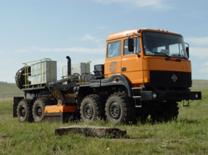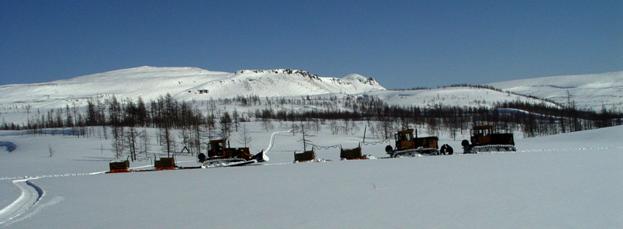Geophysics is one of the most knowledge-intensive areas of mineral resource management. Subsurface studies rely on high technology, and the processing of seismic data requires high performance computers running sophisticated software. Finding new oil and gas fields becomes more challenging with every year and calls for continuous development of geophysics and innovation. Notably, it is East Siberian geophysicists who made and brought on stream the innovative Yenisei electromagnetic pulse source.
Yenisei is a proprietary product of GEOTEK production facility Evenkiyageophysika. This unique equipment made in Siberia is unparalleled on a global scale and captures the interest of experts across the world, as Yenisei is an environmentally-friendly non-explosive seismic prospecting method that offers a unique take on the electromagnetic shock technology.

1. Technology description
The new non-explosive seismic prospecting technology attracts great interest globally as a result of:
- Being preferred geographically and geologically in many locations
- Often the best choice environmentally
- A safer alternative to explosive methods.
An electromagnetic pulse source is a non-explosive surface pulse source with electromagnetic power drive comprising one or several synchronized short travel electric magnets and an autonomous power supply system with a capacitor storage
and a charge/discharge unit.
The pulse sources generate seismic pulses with superior parameters and have strong reliability and safety metrics. Unlike other seismic wave generation technology, they have low maintenance requirements, very attractive price/quality ratio, and low operating costs.
2. Application

Key pulse source applications are as follows:
- 2D, 3D, 3C seismic prospecting
- Vertical seismic profiling (VSP)
- Microseismic
- Near surface section surveys
- Engineering surveys.
A distinctive feature of the technology is its minimal environmental footprint, as pulse sources only strain but do not break the ground. This means that pulse sources can be used in the zones where use of other technology is not possible.
Furthermore, the pulse source design allows surveys in hard-to-reach areas and across a variety of terrains, like:
- Arctic tundra;
- Mountain taiga
- Deserts
- Lakes, rivers, transit zones
- Relatively thin ice of water bodies
- Residential, industrial, and conservation areas
- Areas with thick LVLs (low velocity layers) or permafrost.
3. Advantages of pulse sources


Pulse sources have clear advantages over other technology, as confirmed by benchmarking studies, including:
- Simplified field operations and reduced operating costs
- Improved safety of operations
- Ability to prospect across a variety of terrains and weather conditions
- None or minimal environmental footprint
- Ability to generate seismic waves when other technology is prohibited or not feasible.
The pulse sources are widely used on projects with various seismic and geologic conditions, and for all types of seismic surveys.
A variety of available pulse source models, covering a pulse force range of 16–1000 kN, means there is a suitable model for any type of seismic prospecting.
A large-scale R&D project is currently under way to develop pulse source models fit for the Arctic Shelf operations. This would bring almost unlimited potential to the innovative Siberian technology.
4. Types of pulse sources

Currently manufactured types of pulse sources are as follows:
- Sled-mounted (Yenisei SEM-100, SEM-50, SEM-20)
- Wheeled (Yenisei KEM-4, KEM-2, KEM-1)
- Floating (Yenisei VEM-50)
- Portable (Yenisei EM-1.6).
Model comparison:
| Pulse source | Design pulse force, kN | Number of pulse units | Weight | Application |
Seismic survey |
|---|---|---|---|---|---|
| Wheeled: | |||||
|
Yenisei KEM-4 (mounted on URAL-55571 or IVECO-АМТ Trakker trucks) |
1000 | 4 | 19600 kg |
Main pulse source type for land surveys. Designed for summer and winter operations in mountain taiga, tundra, steppes, and deserts. |
2D, 3D, 2D-3C, 3D-3C, VSP, LVL surveys. |
|
Yenisei KEM -2 (mounted on URAL-4320 truck) |
500 |
2 |
14000 kg |
Designed for summer and winter operations in mountain taiga, tundra, steppes, and deserts. |
2D, 3D, 2D-3C, 3D-3C, VSP, LVL surveys. |
| Yenisei KEM-1 (motor vehicle trailer) |
200 |
1 |
1850 kg |
Designed for summer and winter operations in forests, steppes, and deserts. |
LVL and near surface section surveys, engineering surveys. |
| Sled mounted: | |||||
|
Yenisei SEM-100 |
1000 кН | 2 | 7300 kg |
Designed for winter operations in mountain taiga, tundra, steppes, and deserts. |
2D, 3D, 2D-3C, 3D-3C, VSP, LVL surveys. |
| Yenisei SEM-50 |
500 |
2 |
4600 kg |
Designed for winter operations in mountain taiga, tundra, steppes, deserts, and ice of water bodies. |
2D, 3D, 2D-3C, 3D-3C, VSP, LVL surveys. |
| Yenisei SEM-20 | 200 | 1 | 1600 kg |
Designed for winter operations, to be transported to the site by road or air.
|
LVL and near surface section surveys, engineering surveys. |
| Floating: | |||||
| Yenisei VEM-50 | 500 | 1 | 4050 kg | Shallow drafted for seismic prospecting in small rivers, transit zones, and conservation areas in summer. | 2D, 3D, VSP |
| Portable: | |||||
| Yenisei EM-1.6 | 16 | 1 | 280 kg |
Designed for near surface section surveys. |
Engineering surveys. |
Yenisei electromagnetic pulse sources are compatible with all known models of geophones and synchronization systems.
A wide variety of available pulse source models, covering a pulse force range of 16–1000 kN, means there is a suitable model for any type of seismic survey.
